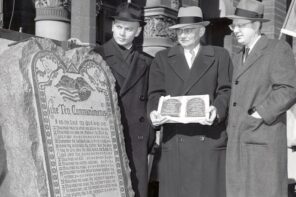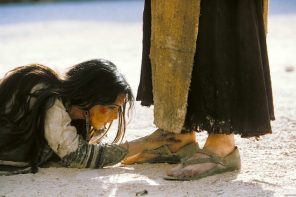The Book of Genesis Illustrated
by R. Crumb
(WW Norton & Co., October 19, 2009)
There is nothing sacred to underground and alternative comics creators. Irreverence has been a defining characteristic of the movement since the 1960s, when creators like R. Crumb and Gilbert Shelton began using the words-and-pictures medium to create scathing, sex-and-drug-filled satires of square culture. No subject was safe from the savage pens of these cartoonists, and religion—or, more specifically, sanctimoniousness—was a common target.
Yesterday, October 19, was the official publication date of Crumb’s Book of Genesis Illustrated, a work five years in the making. Far from the sharp satire that one might expect from the creator of Fritz the Cat and Mr. Natural, Genesis is a remarkably straight, even reverent, adaptation. In his introduction, Crumb explains that he avoided adding interpretation or clearing up confusing passages, leaving the Bible as is “rather than monkey around with such a venerable text… I approached this as a straight illustration job, with no intention to ridicule or make visual jokes.” He notes the irony that devout, didactic Bible comics creators are more willing to play around with scripture by inserting “completely made-up narrative and dialogue,” while he, a non-believer, lets the text speak for itself.
But, as every student of the Bible knows, there’s no such thing as a reading without interpretation. A big challenge from the start: how should God be depicted? In an interview with Time, Crumb explains that he considered rendering God as a light emerging from a cloud, or coyly recontextualizing him as a black woman, but in the end settled on a more pedestrian bearded and robed figure that he says resembles his father: “if you actually read the Old Testament,” he told Time, “he’s just an old, cranky Jewish patriarch.”
The choice of translation is also a matter of importance. Crumb states that his text is compiled from several sources, including the King James version, though it is primarily drawn from Robert Alter’s recent translation in The Five Books of Moses. Clearly, Crumb is more interested in liberal biblical scholarship than evangelical fervor. His purpose here is not to make the text “relevant for modern readers,” but to return it to its Jewish roots from a Christian interpretive framework that refuses to let it stand on its own.
The Matriarchy Hypothesis
The eight pages of notes at the end of the book suggest another agenda, as Crumb reveals his preoccupation with the idea of a pre-Jewish matriarchy hidden beneath the text of Genesis. He frequently refers to “biblical scholars” who support his arguments, but hardly names any (the notable exception being Savina J. Teubal, whose name finally surfaces toward the end of the annotations; it seems that her book Sarah the Priestess was one of Crumb’s major sources).
But Crumb isn’t a scholar, and it’s not entirely fair to ask him to spend too much time substantiating claims that, after all, only appear in the endnotes. The important thing is his visual interpretation of the story, and with a few blink-and-you’ll-miss-them panels showing goddess idols, the matriarchy hypothesis doesn’t break through into Crumb’s visual narrative. Where he does insert footnotes directly into the adaptation, they tend to offer either etymological explanation or curious gee-whiz excitement, as in his exclamation that “Noah was credited with being the first man to make wine! See chapter 9.”

The design of the book’s jacket belies the seriousness of its contents. The back cover places portraits of the major players into captioned circles in homage to the design of EC Comics’ horror titles like Tales From the Crypt. The front, though, which features a customarily serious image of Adam and Eve’s expulsion from Eden, also offers pulpy blurbs (“All 50 chapters—nothing left out!”) and a coy recommendation: “Adult supervision recommended for minors.” The boards themselves, which show only a stately, gold-embossed title that mixes gothic blackletter and Crumb’s own underground-comix typography, is a bit truer to the nature of the contents.
Despite the moderate interpretive philosophy behind the adaptation, there’s no doubt that this is a Crumb comic. His Eve is a typically zaftig seductress, and his panel illustrating Rachel’s “comely features” is as rear-end-focused as one might expect. And because he provides so straight an adaptation, he doesn’t shy away from either the sex or the violence present in the text. But neither does he linger on these moments; the story of Lot’s incestuous encounters with his daughters, which the ’60s Crumb would surely have stretched to at least four lascivious pages, is completed in six panels.
If there’s a weakness in the adaptation, it’s that the visual splendor of events like the creation story and the Flood overshadows the more down-to-Earth sections of the narrative. We keep waiting for something big and exciting to happen. Instead, the panels seem to become smaller as the book goes on, as if the worldly tales of the patriarchs need to humble themselves within smaller panels than the grandly cosmic creation. The result is a bit of visual tedium as we wait for an event that’s big enough for a wider panel.
And yet there’s great beauty in the down-to-Earth depiction of the post-Flood stories. This is not caricature; the faces are drawn in a strikingly realistic style. The genealogy sections, featuring dozens of thumbnail sketches to a page, come across as sketchbook pages drawn from life. The plethora of faces hint at the stories that didn’t make it into Scripture: who was Areli, the youngest son of Gad, or Asher’s daughter Serah? Genesis doesn’t tell us, but Crumb’s fine imaginary portraiture brings character to these unstoried names.
Basil Wolverton’s Bible-as-Bizarre
Crumb’s Genesis is hardly the first instance of an indie comics artist drawing from the Bible. Chester Brown has been slowly releasing dark adaptations of the Gospels since 1987 (Mark is completed, Matthew is still in progress); Kyle Baker’s King David presented the audacious violence of the Hebrew Bible’s hero epic as a bloody cartoon; and underground comix pioneer Frank Stack cut his teeth—and produced the first true underground comic book—with the first issue of The Adventures of Jesus in 1963. But the forefather of underground comics had already built an impressive body of biblical illustration years before Crumb began truckin’—and that work was anything but satirical.
Basil Wolverton was a major influence on Crumb, who has said that Wolverton’s cover to Mad #11 [image right] “changed forever the way that I looked at the world.”  His famously grotesque style can be seen as the starting point for all of the bizarre excesses of the underground comix scene. It’s a bit surprising, then, that Wolverton himself was rather conservative, and undertook a decades-long project of evangelical illustration for Herbert W. Armstrong’s Radio Church of God (later renamed the Worldwide Church of God, and now known as Grace Communion International). This Adventist offshoot was fervently pre-millennialist, and Armstrong saw in Wolverton’s grotesque style the perfect means of capturing and communicating the horrors of the tribulation.
His famously grotesque style can be seen as the starting point for all of the bizarre excesses of the underground comix scene. It’s a bit surprising, then, that Wolverton himself was rather conservative, and undertook a decades-long project of evangelical illustration for Herbert W. Armstrong’s Radio Church of God (later renamed the Worldwide Church of God, and now known as Grace Communion International). This Adventist offshoot was fervently pre-millennialist, and Armstrong saw in Wolverton’s grotesque style the perfect means of capturing and communicating the horrors of the tribulation.
And horrific the illustrations are—with their crashing planes, erupting volcanoes, boil-stricken sufferers, and monstrous whirlwinds—Wolverton’s literalist depictions of Revelation are powerful, shocking, and above all grotesquely beautiful. And though their overall style is more realistic than his more famous work for magazines like Mad, these images are instantly identifiable as Wolverton’s. Much of their horror comes from the fact that his usual monsters are depicted against a realistic background instead of a humorous one.
Following the success of the Revelation illustrations, Armstrong hired Wolverton to collaborate on The Bible Story (collected in print, along with the earlier illustrations as The Wolverton Bible), a retelling of the entire Old Testament that ran from the late ’50s until 1972, two years before a stroke ended Wolverton’s career for good. Though Wolverton’s approach to these stories was somewhat more matter-of-fact than his apocalyptic panoramas, there is still a passion for the bizarre evident in the Bible Story illustrations. Many of the most intriguing images in this series feature outlandish pagan idols depicted with a sense of joy and whimsy that suggest Wolverton’s delight in the more outré aspects of scripture. A more gruesomely playful example is a terrifying image of the blinding of Samson: given the demonizing of the “injury to the eye motif” in Frederic Wertham’s Seduction of the Innocent and the Senate hearings on violent comics that it produced, one wonders if this image wasn’t a sly comment on the broader cultural meaning of violent art.

Apocalypticism is present here, too. The depiction of the Flood, in proper dispensationalist style, is drawn out and extreme. Unlike Crumb, who depicts the death of most of the human race in a single panel, Wolverton has a didactic reason to linger on the scriptural moment—of the 62 pages illustrating the book of Genesis in this volume, the story of the Flood takes up 26. (By comparison, the creation narrative takes up six pages; the story of Joseph seven.) Many of these images depict in gruesome detail the sufferings of those left off of the Ark. The Flood is an important story for pre-millennialists, and thus it served Armstrong’s purposes for Wolverton to linger on its more horrific aspects.
For Wolverton, there was no conflict between his secular comics work and the ministry of his biblical illustrations, and Armstrong had no objection to Wolverton’s sense of humor—indeed, he also hired Wolverton to do humor pieces and wacky spot illustrations for WCG’s publications. Wolverton’s Bible illustrations sit on the border between sacred and profane, and that unique placement is what gives them such power. Despite its very different agenda, Crumb’s Genesis offers a similar sort of pious irreverence.
Ironically, although Crumb’s work is not intended as an evangelical tool, it seems likely that it will reach more people than the average Jack Chick tract, and that reach is directly attributable to its creator’s iconoclastic roots. Read together, Crumb’s Genesis and The Wolverton Bible paint a fascinating picture of outré spirituality—a Weird Testament.




